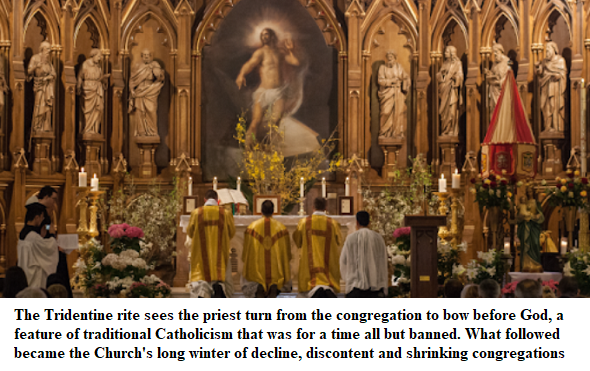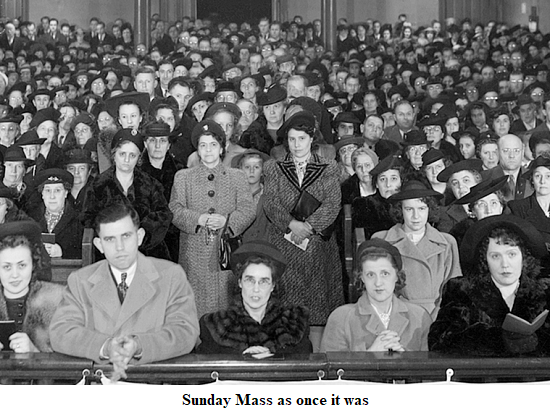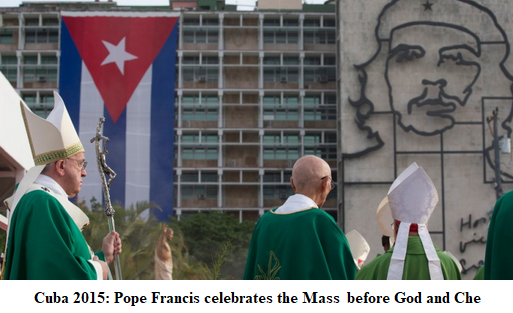
Agatha Christie and the Attempted Murder of the Old Mass

What does Agatha Christie have in common with Joan Sutherland, Graham Greene, Yehudi Menuhin, the actor Ralph Richardson and the austere Cambridge don F. R. Leavis?
Many things no doubt, of which the most obvious is that they were all artists of the first rank in their fields. In particular, though, they have in common that in 1971 they and 51 other men and women of cultural eminence used the power of their reputation to petition Pope Paul VI not to consign the traditional Latin Mass of the Roman Catholic Church, which they noted as having an “exceptional artistic and cultural heritage”, to the oblivion intended for it by the “progressive” liturgical reformers of the time. This was the Mass of Mozart, of Beethoven and Palestrina. Most of the signatories were not Roman Catholics but their petition was successful, in that the Pope gave permission for the old Mass, substantially in the form it had existed since the sixteenth century, to be celebrated in certain circumstances if requested. He is said to have read through the names and stopped at Agatha Christie’s. Davvero? you can picture him saying, looking up from the list, la famosa scrittrice. Perhaps he was a fan; in any event the indult, or act of permission he issued, is still called informally the Agatha Christie Indult, and thousands of Catholics around the world who now worship in the old rite, and all who care about the beleaguered Western cultural tradition, owe the Queen of Detective Fiction and her co-signatories their gratitude.
The attempted suppression of the Mass in the traditional rite known as Tridentine (from the sixteenth-century Council of Trent, at which its form was fixed) was a consequence of the liturgical politics of the Second Vatican Council and its aftermath. The Council had recommended a mild reform to make the cohesion between the various elements of the eucharistic rite more evident. Radical liturgists, who wanted a new rite entirely, managed, as leftists always do in the secular world, to install themselves as the arbiters of change. There was much pseudo-archaeological talk about returning to the simple gatherings of the early Christians, and expressions of pastoral concern, real or affected, for twentieth-century congregations allegedly unable to “understand” Latin (though every Catholic had a parallel vernacular rendering in his Missal). Some thought there was too much emphasis on sinfulness in the Tridentine rite for the feelgood culture already then emerging.
Chiefly, it is now evident that the reformers were motivated by two things: a perhaps laudable if naïve ecumenism that expressed itself in a desire to make the Catholic liturgy more palatable to Protestants; and the loathing all progressives have for tradition and our inherited culture. In this sense the attack on the Mass was an early skirmish in the culture wars that now plague the Western world.
The progressives largely got their way. In 1970 the Tridentine Mass ceased to be the normal Sunday rite in the Catholic Church, and had it not been for the Agatha Christie Indult and several others subsequently granted, would have vanished into history, along with Latin, Gregorian chant, fish on Fridays and other elements in the Catholic heritage the reformers didn’t like. For them, there was no place for nostalgic survivals of the benighted past in the new “spirit-filled” Church they were seeking to bring into being by exploiting the weakness of a shilly-shallying Pope to go beyond the moderate changes sanctioned by the Council. They spoke extravagantly of a “new springtime” for the Church, of a “new Pentecost”. As it happened, their attack on traditional Catholicism ushered in a long winter of decline and discontent, of shrinking congregations, of Catholic schools decatholicised, Catholic opposition to abortion and other social ills ignored, which has seen the Church reduced and marginalised, to the delight of secularists who have seized on child sexual abuse to put the boot in further. COVID has made things much worse with the closure of churches.

In the gloomy landscape of contemporary Catholicism one light burns steadily. The reintroduction of the old Mass, now officially known as the Extraordinary Form or EF, has been a success, though still a limited one. Its re-emergence after years of only occasional celebration under the “Christie Indult”, is due to Pope Benedict XVI, who in his motu proprio of 2007 Summorum Pontificum stipulated that any priest had the right to say Mass in the old form and removed the power of bishops, a body of men in whom the fading flame of the new Pentecost still flickers here and there, to forbid them. In fact, many bishops support the old Mass and some have celebrated it.
So far so good. But all at once it seems possible that another “Christie” campaign might become necessary. Pope Francis, with his Peronist penchant for oblique hints when controversial decisions are in the air, let it drop at a conference of Italian bishops in late May that he intends to “reform” the motu proprio. “Reform” in Francis’s lexicon could mean anything from a revised instruction in his own name to an abrogation. The latter would be foolish, uncharitable and could possibly lead to a split in the Church, the last thing you’d think a Pope would want in this aggressively secular age.
Sadly, experience suggests that Pope Francis is not deterred by consequences or unpopularity when he resolves to do something, witness his nasty deal with the Chinese Communist government, which has sold Chinese Catholics loyal for decades to the Vatican down the river in favour of the Beijing-controlled “patriotic Church”; or his implicit instruction to American bishops not to withhold Communion from President Biden, whose party he openly favours but whose encouragement of abortions is in conflict with Catholic moral teaching. At the time of writing Catholics are just having to wait and see what the Pope decides to do about the motu proprio, which is exactly the way he likes it, with everyone hanging on his word. (For a discussion of Pope Francis’ political techniques, see “The Puzzle of the Pope” in Quadrant‘s December 2020 edition.)
Meanwhile, around the world the traditional Mass is offered in hundreds of churches in every continent. In Australia, the Latin Mass Directory lists 64 churches and chapels, in all states, including the cathedrals of Sydney and Melbourne. In both those cities, and in Adelaide, it has a growing and thriving parish dedicated exclusively to its celebration. In Brisbane there is the Oratory in formation where the traditional Mass is celebrated daily. And, as younger priests take charge of parishes, it is beginning to filter out into the wider Church where it attracts higher than average congregations.
Indeed, it is among congregations attending the EF Mass that there is evidence of Catholicism, slowly, beginning to grow again. And it is growing among the young, with statistics disproving the canard, still occasionally heard in progressive circles, that it is only ancient “nostalgics”, reared on the EF Mass when it was the norm, who wish to attend it now. If a few do, they must be very old indeed and would have been teenagers when it was discontinued. Instead it is teenagers who go to it now. A pre-COVID world survey commissioned by the Vatican found, in the words of Oxford philosophy lecturer Joseph Shaw of the British Latin Mass Society, that Catholics who regularly attend an EF Mass “are disproportionately young, and include a disproportionate number of families with small children.” Millennials who are likewise conspicuous by their absence in most churches are also there in numbers.
Attenders at an EF Mass speak of being drawn by a quiet ritual power that – to non-believers outrageously – presumes to invite its followers into a reality beyond the quotidian. There is a profound sense of reverence, partly on account of the relative silence during the most solemn part of the service, the Canon, the long prayer in which the priest consecrates the eucharistic elements, when only the murmur of the Latin is audible, or if it is a High Mass with full ceremonial, the music, which is often very fine. The use of Latin, much of which is fairly easily memorised, underlines the continuity of the Mass through the centuries and its invariability throughout the world and serves the practical purpose of retaining a fixed meaning and avoiding the changes of idiom and nuance to which a vernacular language is subject over time.
It is the sense of total dedication to prayer, total absorption in the rite, which most strikes newcomers to the EF Mass. In the newer rite, the way it is usually celebrated in parishes, there seems to be always something distracting going on: the congregation is up and down, down and up, standing, sitting, kneeling or (what more people dread than would admit it) shaking hands with each other at the ceremony of exchanging the “peace”. (The pandemic, being a very ill wind but not one that has blown no good at all, stopped that, if only temporarily.)

Naturally the progressive opposition was not extinct even before Pope Francis started dropping hints. Just recently a prominent American Jesuit, displaying the dictatorial streak of the true contemporary liberal, said that children “should not be allowed” to go to the EF Mass, presumably because in them lies its future. Liberals always want everything their own way; they can never live and let live. This is true of one diocese in Victoria where the bishop, though he cannot (yet) ban the old Mass, has, to put it mildly, done nothing to encourage it.
It has been argued that there is a gulf between those who attend the 1970s Mass and those attached to the old one, that there is already a de facto schism, which Pope Francis has seemed occasionally to encourage with disobliging remarks about “traditionalists” and their “rigidity”. Hitherto these traditionalists have comforted themselves with Mandy Rice-Davies’ observation that “he would say that, wouldn’t he?” since Francis himself is the embodiment of post-Vatican II progressivism. But his allusions to “reform” have gone further than that and it is not inconceivable he will seek to forbid or limit the celebration of the EF Mass. That will put many Catholics, including the young – a valuable constituency in an ageing Church – in the unenviable position of being torn between their loyalty to the Pope and their loyalty to the rite, with the real possibility of schism as a result. Catholics respect the Pope as a symbol of unity. Would any Pope, even one with as little regard for the opinions of those who disagree with him as Francis, really wish to go down in history as having engineered the destruction of the unity he is supposed to safeguard?
Perhaps more immediately to be guarded against is a temptation on the part of EF Massgoers to consider themselves superior in their practice of religion to those who attend the newer Mass. This is the sin of pride: hard to avoid but inimical to unity and charity, and perhaps it is a perception of this that is at the heart of what Pope Francis has been imputing to traditionalist Catholics. But if it can be avoided, and if the Pope for his part contains the impulse not to leave well alone, the Catholic Church will continue to be enriched by its rediscovery of the Tridentine rite. As this venerable liturgical action seeps through the consciousness of Roman Catholics, it will create a habit of mind in which they will become more aware of, and will value more highly, their heritage of devotional culture; and non-Catholics will continue to have access if they wish to a high aesthetic experience. It would hardly take one of Agatha’s detectives to deduce how pleased she and her co-signatories would be about that.
Christopher Akehurst, a frequent contributor, lives in Melbourne
Madam: Archbishop Fisher (July-August 2024) does not resist the attacks on his church by the political, social or scientific atheists and those who insist on not being told what to do.
Aug 29 2024
6 mins
To claim Aborigines have the world's oldest continuous culture is to misunderstand the meaning of culture, which continuously changes over time and location. For a culture not to change over time would be a reproach and certainly not a cause for celebration, for it would indicate that there had been no capacity to adapt. Clearly this has not been the case
Aug 20 2024
23 mins
A friend and longtime supporter of Quadrant, Clive James sent us a poem in 2010, which we published in our December issue. Like the Taronga Park Aquarium he recalls in its 'mocked-up sandstone cave' it's not to be forgotten
Aug 16 2024
2 mins







